
Strobilanthes is a genus of about 350 species of flowering plants in the family Acanthaceae, mostly native to tropical Asia and Madagascar, but with a few species extending north into temperate regions of Asia. Many species are cultivated for their two-lipped, hooded flowers in shades of blue, pink, white and purple. Most are frost-tender and require protection in frost-prone areas. The genus is most famed for its many species which bloom on long cycles of several years, such as Strobilanthes wightii which blooms every thirteen years.

Carl Sigismund Kunth was a German botanist. He was also known as Karl Sigismund Kunth or anglicized as Charles Sigismund Kunth. He was one of the early systematic botanists who focused on studying the plants of the Americas. Kunth's notable contributions include the publication of Nova genera et species plantarum quas in peregrinatione ad plagam aequinoctialem orbis novi collegerunt Bonpland et Humboldt. This work spanned seven volumes and was published between 1815 and 1825.
Monocarpic plants are those that flower and set seeds only once, and then die.

Strobilanthes kunthiana, known as Kurinji or Neelakurinji in Malayalam and Tamil and Gurige in Kannada, is a shrub of the bear's breeches family (Acanthaceae) that is found in the shola forests of the Western Ghats in Kerala, Karnataka and Tamil Nadu. The purplish blue flower blossoms only once in 12 years, and gave the Nilgiri Mountains range its name as nil (blue) + giri (mountains). The name Neelakurinji originates from the Malayalam language neela (blue) + kurinji (flower). Of all long interval bloomers Strobilanthes kunthiana is the most rigorously demonstrated, with documented bloomings in 1838, 1850, 1862, 1874, 1886, 1898, 1910, 1922, 1934, 1946, 1958, 1970, 1982, 1994, 2006 and 2018, these have no match to Solar cycles.
Plietesials are plants that grow for a number of years, flower gregariously (synchronously), set seed and then die. The length of the cycle can vary between 8 and 16 years. For example, the neelakurinji plant flowers every 12 years and bloomed as expected in 2006 and 2018 in the Munnar region of Kerala, India.

Gracillariidae is an important family of insects in the order Lepidoptera and the principal family of leaf miners that includes several economic, horticultural or recently invasive pest species such as the horse-chestnut leaf miner, Cameraria ohridella.
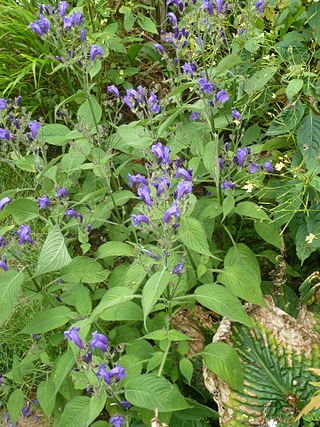
Strobilanthes wallichii, commonly known as Kashmir acanthus, hardy Persian shield, wild petunia, or kandali, is a herbaceous perennial which is native to the Himalayas. In its natural habitat, it purple blooms appear only once every twelve years, an occasion which is celebrated by the Kandali Festival in the Pithoragarh District in India.
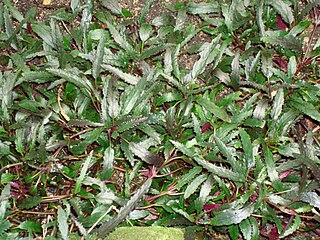
Strobilanthes sinuata is a species of plant of family Acanthaceae.
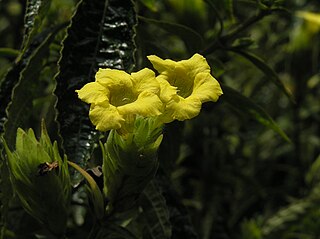
Strobilanthes crispa is a shrub which originated from Madagascar, and is now found across south east Asia. It is a member of the family Acanthaceae. It is known as pokok pecah kaca or pokok pecah beling in Malaysia, and pecah beling, enyoh kilo, kecibeling or kejibeling in Indonesia. The leaves are used traditionally for treatment of cancer and diabetes, usually taken as a tea or infusion of the leaves.
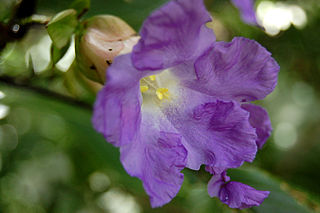
Strobilanthes callosa(Synonym: Carvia callosa Bremek) is a shrub found mainly in the low lying hills of the Western Ghats, all along the west coast of India. Its standardized Hindi name is maruadona (मरुआदोना) which it is called in the state of Madhya Pradesh where it is also found. In the state of Maharashtra, in the Marathi language, and other local dialects and in the neighboring state of Karnataka, the shrub is locally known as karvi (कारवी), sometimes spelled in English as karvy.

Junonia iphita, the chocolate pansy or chocolate soldier, is a butterfly found in Asia.
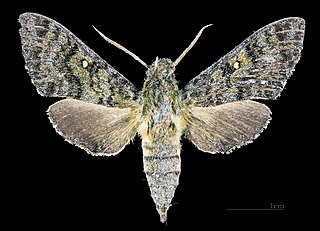
Pseudodolbina fo, the acanthus hawkmoth, is a moth of the family Sphingidae. It is found from Nepal, Bhutan and north-eastern India into Tibet.

Gracillariinae are a subfamily of moths which was described by Henry Tibbats Stainton in 1854.

Strobilanthes dyeriana, the Persian shield or royal purple plant, is a species of flowering plant in the acanthus family Acanthaceae, native to Myanmar.
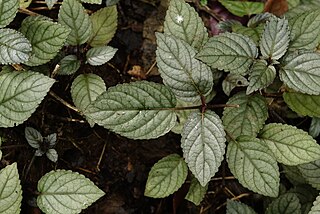
Strobilanthes alternata, may be known as red ivy, red-flame ivy, or waffle plant, is a member of the family Acanthaceae native to Java. It is a prostrate plant with purple colored leaves.
Strobilanthes penstemonoides is a species of flowering plant in the family Acanthaceae. It occurs in China, Bhutan, India, and Nepal. Its specific epithet has been spelled as penstemonoides, pentstemonoides, and pentastemonoides.
Strobilanthes capitata is a species of flowering plant in the family Acanthaceae.

Strobilanthes integrifolius is a species of plant in the family Acanthaceae. Commonly known as Thottukurinji, it is found in the Western Ghats in the South Indian regions of Kerala, Goa, Maharashtra and Karnataka. Especially the flower plant originally illustrated by Dalz., And was given the exact name of Carl Ernst Otto Kuntze the Strobilanthes integrifolius.
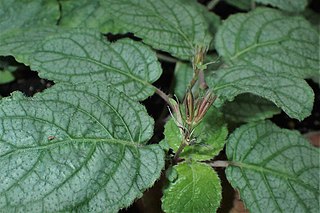
Strobilanthes reptans is a species of Strobilanthes native to Tropical and Subtropical Asia and the West Pacific, but also found in Florida and Louisiana after being introduced. It has at 35 synonyms mainly in the genus Hemigraphis with 28, another 5 in Ruellia plus Strobilanthes primulifolia and Strobilanthes tawadana. It has been described as an invasive weed around the Indo-Pacific islands region, with an ornamental appearance.

Strobilanthes cusia, also known as Assam indigo or Chinese rain bell, is a perennial flowering plant of the family Acanthaceae. Native to South Asia, China, and Indochina, it was historically cultivated on a large scale in India and China as a source of indigo dye, which is also known as Assam indigo. In addition to being used for dye, it is also used in the traditional Chinese herbal medicine "Qingdai". Other names for this dicot include Pink strobilanthes and Strobilanthes flaccidifolius, where flaccidifolius is Latin for "drooping leaves".















